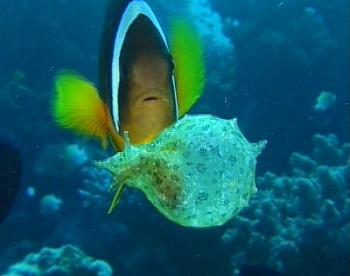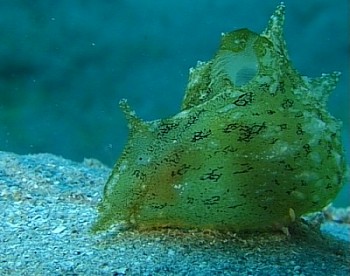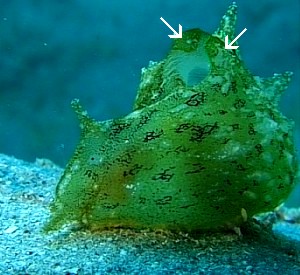Notarchus indicus swimming
June 28, 2000
From: Jochen Scholtyssek


Dear Bill,
I took this Video in the Red Sea at a daydive in April 2000.
ROYAL Diving Center, Akaba, Jordan. Depth 15m.
I have no idea of it`s ID. - Aplysia dactylomea? Anaspidea? German:Seehase?
Jochen Scholtyssek
56170 Bendorf-Sayn
Hellenpfad 30
Germany
joscholty@t-online.de
Scholtyssek, J., 2000 (Jun 28) Notarchus indicus swimming. [Message in] Sea Slug Forum. Australian Museum, Sydney. Available from http://www.seaslugforum.net/find/2633
Dear Jochen,
This is definitely an Anaspidean or Sea Hare but it is a bit more interesting than Aplysia dactylomela.
It is a species of Notarchus, Sea Hares which are able to swim by jet propulsion, as your animal is doing in the top photo. In most Sea Hares the parapodia are large flaps on the side of the body which fold over to enclose the reduced and flattened shell and mantle cavity. [See the page on Syphonota geographica for a good photo of a typical Sea Hare with opened parapodia showing the mantle cavity]. Some species are able to swim by flapping the parapodia a bit like a bird uses its wings [See photo of Aplysia extraordinaria swimming]. The parapodia in Notarchus however, are fused together, except for a small opening at the anterior end. The fused parapodia mean that the body of Notarchus is effectively enclosed in its own bag or sac. In the following description of how it swims, I will call the cavity enclosed by this parapodial sac the parapodial cavity. The small section of unjoined parapodial edge at the opening to the parapodial sac have become small lobes [see arrows in your photo alongside]. These two lobes control the movement of water in and out of the parapodial sac. When Notarchus is crawling, or at rest, water for breathing is directed in and out of the parapodial sac between the two lobes. In normal Sea Hares the parapodial edge forms a temporary anterior inhalent siphon to direct water into the mantle cavity and a temporary posterior exhalent siphon to expel deoxygenated water. Because the opening is so small in Notarchus, it has to take turns at being both the inhalent and exhalent siphon. When water is being drawn into the cavity, the two mantle lobes fold down over the back of the parapodial opening so water is sucked in anteriorly. When water is being expelled the flaps close over the anterior end so water is expelled posteriorly.
However when the animal is disturbed and feels the urgent need to escape, the lobes join to form a funnel around the whole of the parapodial opening, quickly drawing in enough water to blow up the parapodial cavity so the slug looks like a balloon [see your upper photo]. When the cavity is 'full', the lobes fold down over the parapodial opening to leave only a narrow posterior funnel. The parapodial lobes quickly contract and the water is expelled in a strong jet, propelling the animal up off the bottom. As it rises, water is again sucked into the cavity, and when fully expanded, it is again jetted out, keeping Notarchus swimming. During this swimming phase, Notarchus undergoes a series of backward somersaults. The result is quite spectacular, if not very elegant. It is clearly designed to quickly remove Notarchus from a place of immediate danger, rather than as a means of serious movement from one place to another.
If you have other photos of this animal swimming I would very much like to see them.
There are two species of Notarchus which can only be satisfactorily separated by looking at their reproductive system - Notarchus punctatus has penial spines, and N. indicus does not. Since your animal is from the Red Sea, I think it is most probably Notarchus indicus. If you would like some more general information on Sea Hares go to the Sea Hares Page.
Reference: Martin, R. (1966) On the swimming behaviour and biology of Notarchus punctatus Philippi (Gastropoda, Opisthobranchia). Pubbl. Staz. Zool. Napoli, 35: 61-75.
Best wishes,
Bill Rudman.
Related messages
-
Re: Notarchus indicus at Eilat
From: Binyamin Koretz, February 17, 2006 -
Notarchus indicus at Eilat
From: Bill Rudman, March 15, 2005 -
Re: Notarchus from Hawaii
From: John Hoover, August 3, 2000 -
Strange Sea Hare from Hawaii
From: John Hoover, August 2, 2000 -
More photos of Notarchus swimming
From: Jochen Scholtyssek, July 6, 2000
